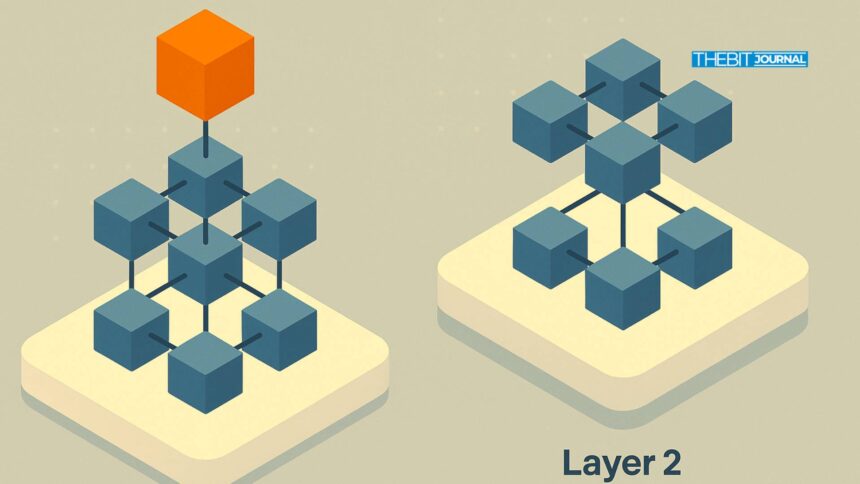As the crypto world expands beyond digital currencies, the infrastructure that drives this revolution is under great pressure to grow, adapt, and innovate. At the heart of this progression is a technical issue that has ignited heated debate: Layer 1 vs Layer 2 crypto. These two unique approaches to blockchain scaling influence the speed, cost, and user experience of anything from DeFi systems to gaming metaverses.
While Bitcoin and Ethereum served as Layer 1 blockchains, increasing congestion and hefty gas prices have paved the way for Layer 2 alternatives such as Arbitrum, Optimism, and Polygon. Understanding the distinction between Layer 1 and Layer 2 blockchains is no longer just technical jargon; it is required knowledge for anybody navigating cryptocurrency in 2025 and beyond.
Layer 1: The Base Layer That Started It All
Layer 1 blockchains are the foundational layer for all decentralized applications (dApps) and protocols. These blockchains include Bitcoin, Ethereum, Solana, Avalanche, and Cardano. They manage everything from consensus procedures and transaction validation to smart contract execution.
The most significant benefit of Layer 1 systems is their decentralization and security. These networks are often powered by Proof of Work (such as Bitcoin) or Proof of Stake (such as Ethereum 2.0), and they ensure the integrity of the blockchain from the bottom up. However, Layer 1 blockchains have limited transaction throughput. Ethereum, for example, can only process around 15 transactions per second, rendering it unsuitable for large-scale dApp use without significant modifications.
That is where the Layer 1 versus Layer 2 crypto debate becomes heated, because no matter how safe or decentralized a blockchain is, if it cannot grow effectively, adoption suffers.
Layer 2: The Scalability Power-Up for Layer 1 Chains
Layer 2 blockchains are created on top of Layer 1 networks to boost scalability, speed, and cost-effectiveness. They function as auxiliary frameworks, processing transactions off-chain and then settling them on the Layer 1 foundation to reduce congestion and gas prices.
Popular Layer 2 projects, such as Arbitrum and Optimism, use rollup technology, either optimistic or zero-knowledge (ZK), to package thousands of transactions off-chain before presenting a proof to Ethereum. Meanwhile, sidechains like as Polygon provide their own validator networks while occasionally anchoring to Ethereum for security. These advances enable users to connect with dApps and transmit tokens for a fraction of the cost and time.
As developers and businesses strive for widespread adoption, the layer 1 vs layer 2 crypto debate isn’t about picking sides, it’s about optimizing both levels for the greatest experience.
Real Use Cases: Why the Layer 1 vs Layer 2 Crypto Debate Matters
In 2024 and 2025, DeFi, NFTs, Web3 gaming, and institutional finance will all put strain on blockchain performance. For example, an NFT minting event on Ethereum Layer 1 might result in high gas costs and network congestion. However, with Layer 2 technologies like as StarkNet or zkSync, the exact mint occurrences may happen effortlessly and affordably.
Furthermore, businesses deploying tokenized assets or supply chain solutions cannot afford the time and expense of Layer 1 implementation. As a consequence, most real-world applications today employ Layer 2 for speed and affordability, with a periodic return to Layer 1 for finality and security.
Ethereum co-founder Vitalik Buterin recently noted, “Scalability must come from Layer 2 rollups if we’re to support global-scale applications,” emphasizing the need of both levels coexisting for crypto to live up to its potential.
Future Trends: Modular Chains and the Merge of Layers
As blockchain architecture grows, modular frameworks are gaining popularity. Instead of depending on a single chain to handle everything, developers are creating chains that specialize in execution, consensus, or data availability. This tendency is transforming the layer 1 vs layer 2 crypto argument into a collaborative future in which various levels play distinct roles.
Celestia, for example, is a modular Layer 1 focused on data availability, with Layer 2s connecting to it for transaction execution. This new ecosystem breaks down the monolithic approach of early blockchains, promoting more efficient growth.
With Ethereum leading the way in Layer 2 adoption and other Layer 1 chains like Solana investigating their own scaling enhancements, users may anticipate seamless cross-layer interaction, cheaper prices, and more functionality.
Conclusion: The Road to Mass Adoption Runs Through Both Layers
Based on the latest research, layer 1 vs layer 2 crypto, the advancement of blockchain infrastructure is no longer about Layer 1 or Layer 2; it’s about how they can coexist. Layer 1 offers the foundation, decentralization, and security, while Layer 2 gives the performance and efficiency required for worldwide adoption.
In 2025, the layer 1 vs layer 2 crypto debate will remain essential to innovation, particularly as institutions, governments, and entrepreneurs develop more complicated blockchain applications. The more seamless these layers get, the closer crypto gets to being a normal part of life.
For more crypto insights, visit our platform for the latest news and price predictions.
FAQs
What is a Layer 1 blockchain?
A Layer 1 blockchain is the base network, like Bitcoin or Ethereum, that handles transaction processing and security directly on-chain.
What is a Layer 2 blockchain?
Layer 2 solutions sit on top of Layer 1 blockchains to scale them, enabling faster and cheaper transactions without compromising decentralization.
Why are Layer 2 solutions important?
They reduce congestion, lower fees, and make blockchain apps more accessible to users by improving scalability.
Can Layer 2 work without Layer 1?
No, Layer 2 depends on Layer 1 for security and final settlement. They complement each other.
Which Layer 2 projects are most used?
Popular Layer 2s include Arbitrum, Optimism, zkSync, and Polygon, especially within the Ethereum ecosystem.
Glossary of Key Terms
Layer 1 – The base blockchain protocol (e.g., Ethereum, Bitcoin) is responsible for transaction verification and network consensus.
Layer 2 – A secondary protocol built on top of a Layer 1 blockchain to improve scalability and performance.
Rollup – A Layer 2 scaling solution that bundles transactions off-chain and submits a proof to the Layer 1 chain.
Sidechain – A separate blockchain that runs in parallel to the main chain but is interoperable with it.
ZK Rollup – A type of rollup that uses zero-knowledge proofs for secure and efficient transaction validation.
Optimistic Rollup – A rollup that assumes transactions are valid by default and challenges only occur when fraud is suspected.
Modular Blockchain – A blockchain design that separates consensus, execution, and data availability into distinct layers.
Sources/References
www.coindesk.com/learn/layer-1-vs-layer-2-blockchain-explained/





























